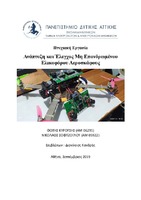| dc.contributor.advisor | Κανδρής, Διονύσιος | |
| dc.contributor.author | Σοφτζόγλου, Νικόλαος | |
| dc.contributor.author | Κυρούσης, Φώτης | |
| dc.date.accessioned | 2020-07-21T07:14:27Z | |
| dc.date.available | 2020-07-21T07:14:27Z | |
| dc.date.issued | 2020-06-15 | |
| dc.identifier.uri | http://okeanis.lib2.uniwa.gr/xmlui/handle/123456789/5331 | |
| dc.description.abstract | O τομέας των Μη Επανδρωμένων Αεροσκαφών (ΜΕΑ) έχει απασχολήσει εδώ και καιρό την Επιστήμη. Τα πρώτα ΜΕΑ είχαν καθοδήγηση μέσω τηλεχειρισμού, ενώ με την βελτίωση των μικροελεγκτών μπορούν να είναι αυτόνομα. Μέσω του μικροελεγκτή υπάρχει δυνατότητα να προσαρμοστεί το αεροσκάφος σε κάθε εξωτερική αλλαγή των περιστάσεων πτήσης. Αντικείμενο της Πτυχιακής Εργασίας είναι η ανάπτυξη ενός ελικοφόρου πτητικού οχήματος τύπου drone και η σχεδίαση και υλοποίηση του συστήματος προγραμματιζόμενου ελέγχου του μέσω μικροελεγκτή και κατάλληλης διασύνδεσης αντίστοιχων αισθητηρίων.
Στη συγκεκριμένη διατριβή το ΜΕΑ που αναπτύχθηκε είναι τύπου Quadcopter. Τα ΜΕΑ αυτού του τύπου χρησιμοποιούν δύο πανομοιότυπα ζευγάρια ελίκων, δύο δεξιόστροφα και δύο αριστερόστροφα και επιτυγxάνουν τον έλεγχο κίνησης κάνοντας χρήση της ανεξάρτητης μεταβολής της ταχύτητας του κάθε στροφείου. Ειδικότερα, αλλάζοντας την ταχύτητα του κάθε στροφείου είναι δυνατόν να επιτυγχάνεται μία ορισμένη συνολική ώθηση, για να εντοπιστεί το κέντρο ώθησης τόσο πλευρικά όσο και διαμήκως και να δημιουργηθεί η επιθυμητή συνολική ροπή.
Ο μικροελεκτής που χρησιμοποιήθηκε για τον ελεγκτή πτήσης είναι ο ArduinoMega2560. Για ραδιοεπικοινωνία χρησιμοποιήθηκε ο πομποδέκτης NRF24L01, γυροσκόπιο και επιταχυνσιόμετρο σε μία μονάδα, κινητήρες , ηλεκτρονικοί ρυθμιστές ταχύτητας, μπαταρία LiPo, πλαίσιο και έλικες. | el |
| dc.format.extent | 111 | el |
| dc.language.iso | el | el |
| dc.publisher | Α.Ε.Ι. Πειραιά Τ.Τ. | el |
| dc.subject | TPSH::Τεχνολογία::Αυτόματος Έλεγχος::Προγραμματιζόμενοι Ελεγκτές | el |
| dc.title | Ανάπτυξη και έλεγχος μη επανδρωμένου ελικοφόρου αεροσκάφους | el |
| dc.title.alternative | Development and control of an unmanned aerial vehicle | el |
| dc.type | Πτυχιακή εργασία | el |
| dc.contributor.committee | Πρέκας, Κλεάνθης | |
| dc.contributor.committee | Παπαποστόλου, Σταύρος | |
| dc.contributor.department | Τμήμα Ηλεκτρονικών Μηχανικών Τ.Ε. | el |
| dc.contributor.faculty | Σχολή Τεχνολογικών Εφαρμογών | el |
| dc.subject.keyword | Μη επανδρωμένα αεροσκάφη | el |
| dc.subject.keyword | Quadcopter | el |
| dc.subject.keyword | Arduino Mega | el |
| dc.subject.keyword | Arduino | el |
| dc.subject.keyword | Μικροελεγκτές | el |
| dc.description.abstracttranslated | Τhe Unmanned Aerial Vehicle sector has been around for science for a long time. The first UAVs have been guided by remote control, whereas with the improvement of microcontrollers they can be autonomous. There is the ability that the aircraft adjusts to every external change of the flight conditions via the microcontroller. The objective of the thesis is the development of a helicopter vehicle of the drone type and the planning and implementation of the programmable control system via microcontroller and the suitable connection of the corresponding sensors. In our dissertation the kind of UAV that was built has 4 propellers, thus it‘s called Quadcopter. Those use two identical pairs of propellers, two clockwise and two counterclockwise. They utilize the independent speed change of each rotor to achieve control. By changing the speed of each rotor it is possible to attain a certain total thrust, to locate the center of impact both laterally as longitudinally and to create the desired total torque. Arduino Mega 2560 is the the microcontroller used for the flight controller. Additionally, the system built includes a radio transceiver, a gyroscope and an accelerometer in one unit, motors, electronic speed controllers, a LiPo battery, frame and propellers. | el |

